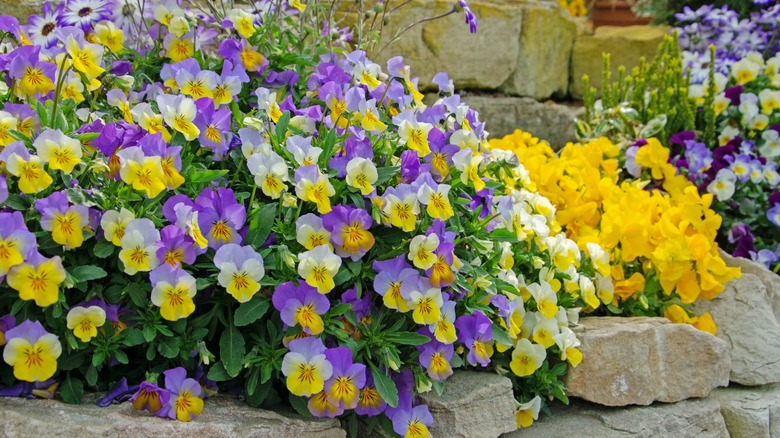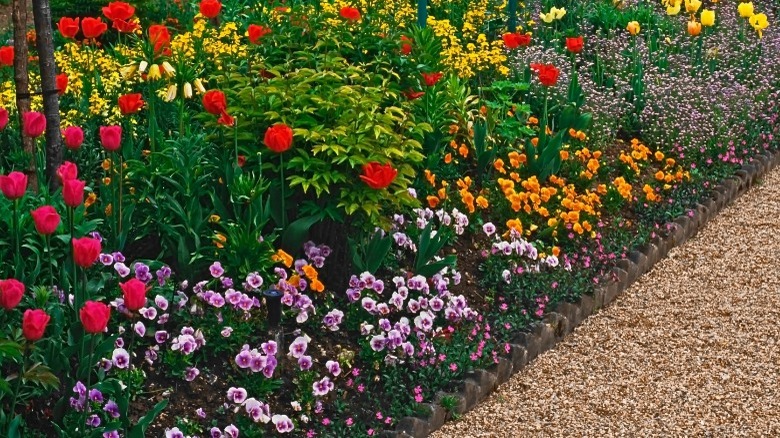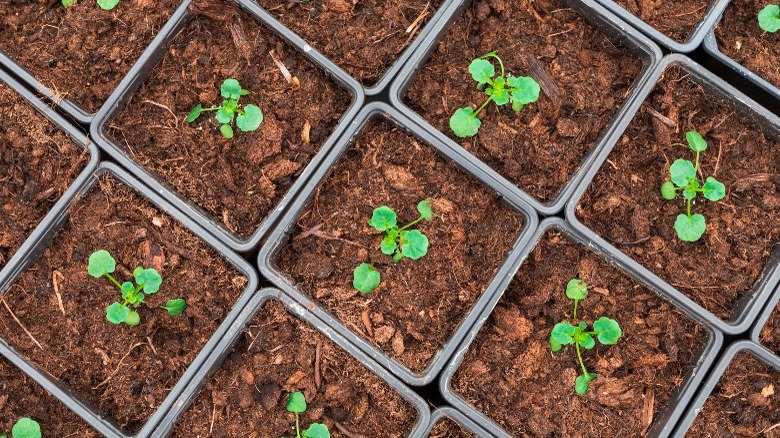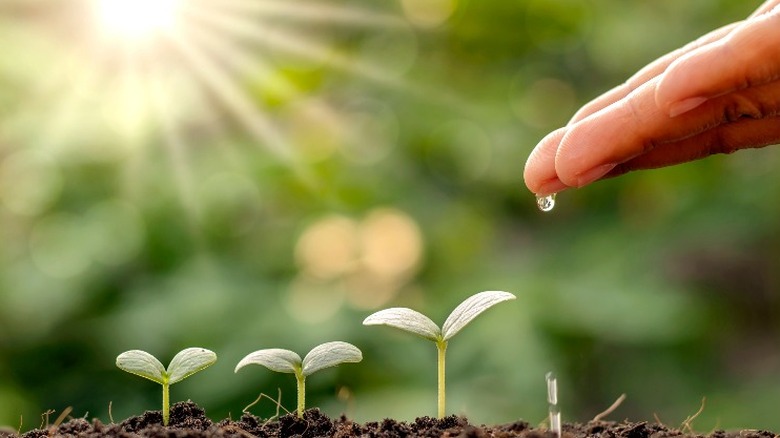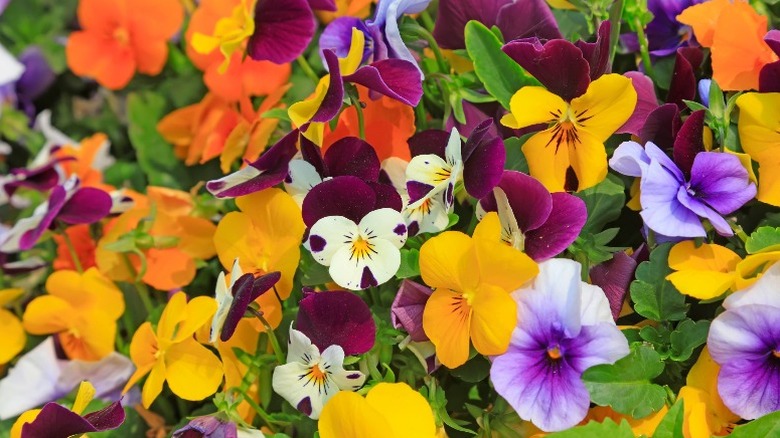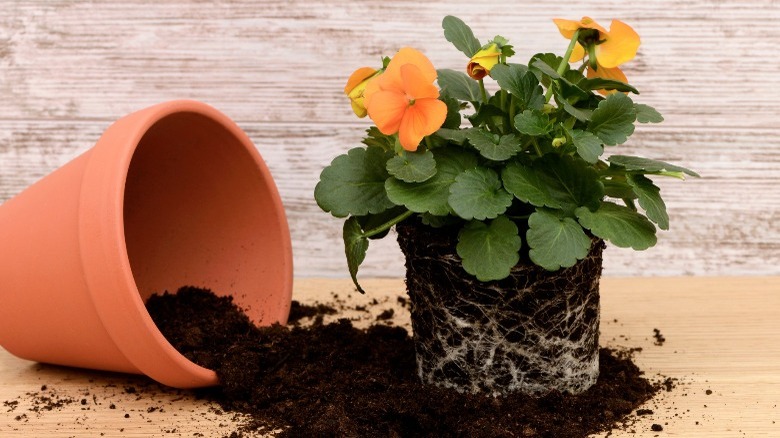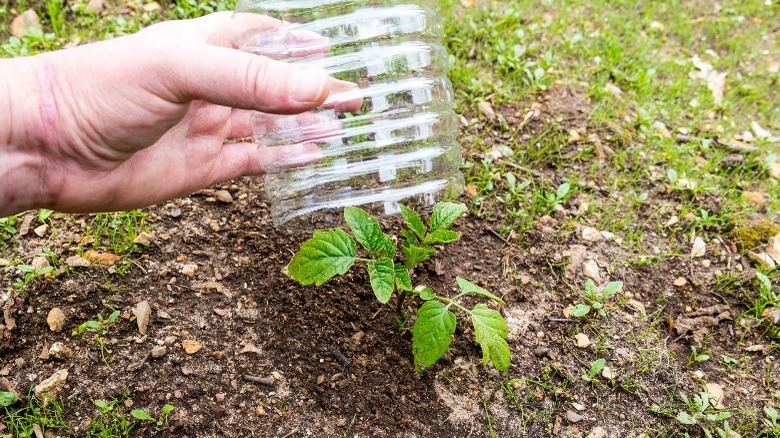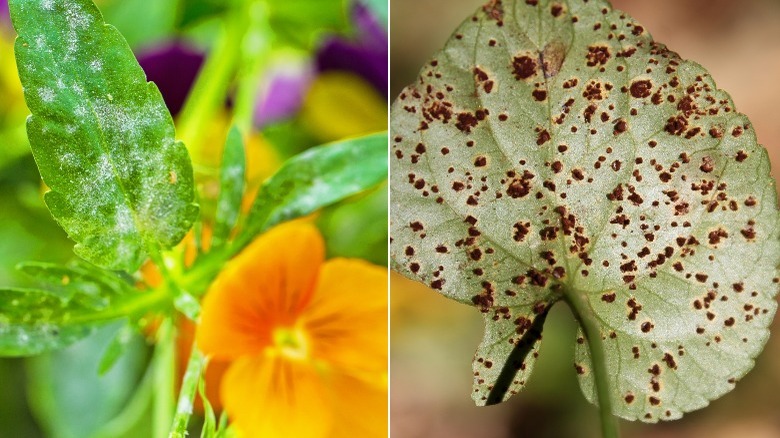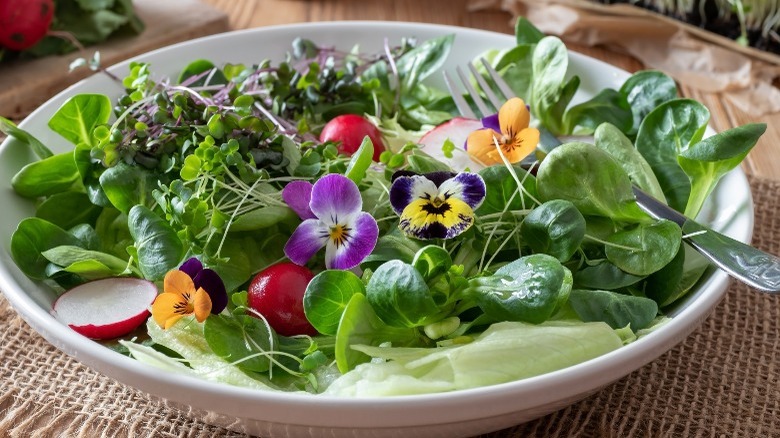How To Grow And Take Care Of Violas
In the world of plants, viola is the broad genus category of the violet plant family (violaceae), with over 550 species, according to American Meadows. They are colorful little flowers easily identified by the central petal markings on some varieties which look like a face. Many people call them "pansies," but violas are actually the flower from which pansies originated. Sometimes they are also referred to as "Johnny-jump-ups" or "heart's delight".
Violas are more compact than pansies, usually growing under 8 inches in height with a spread of up to 12 inches. They have a smaller flower and smaller leaves than pansies, but they have more blooms. Some varieties are longer stemmed which makes it easier to gather them as a bouquet for a small vase. Viola gardening specialists Laura and Jack Wildgoss informed Rare Plant Fair that violas have one of the longest growing seasons starting in early to late fall, with the proper care. They grow in a bright range of colors, and some varieties have several colors on one bloom. They are easy to grow, either from seed or seedlings. Gardener Mark Lane shows you how to also grow violas from root cuttings. Certain varieties of violas are true perennials and will come back every year. Modern hybrids are better treated as annuals and replaced each year. Finally, violas have many uses including culinary, medicinal and fragrance.
How to use violas in garden
Violas make great border plants in your garden and are often recommended for ground cover, according to Learning With Experts. They will spread and make flowering clumps, particularly under shrubs such as roses, with which they combine very well. You can also grow them alongside your vegetables since violas are edible. Additionally, violas come in a large range of colors and can be striped, splashed, bicoloured, or many shades of white, yellow, peach, pink, mauve, purple, and blue. Use them to create various color schemes with other flowers in your garden.
One way to create a very full, blossoming garden, even in a small space, is by planting violas in layers, or over-planting with bulbs like tulips and daffodils, according to Easy to Grow Bulbs. Flower bulbs are planted further into the ground depending on the flower, while the viola seeds can be sown on top. Decide whether you want to plant them as coordinated blooms where all the varieties will bloom at the same time, or utilize sequential blooming, where one flowers starts to bloom as another is fading away. If you prefer to grow violas in containers, gardener David Epstein shows you how (via Growing Wisdom).
How to grow violas
You can start growing violas indoors from seeds eight to 12 weeks before the last frost. Or, you can sow them directly into your garden, although many gardeners suggest that this method is less successful, per Johnny's Selected Seeds. If you start violas in a seed starting container, fill the containers with potting soil either with or without seed starter mixed in. If you use a seed starter mix, you do need to add some water to it before you plant your seeds, says Chista's Garden. You only need to place three to four seeds on top in each small cell; there's no need to push them down into the soil. Then cover the seeds with a thin layer of compost that has been sifted to remove twigs or bark.
In order to germinate, violas have to be kept in the dark so cover them lightly for seven to 14 days. When the plants have two true leaves, remove the cover and thin out the seedlings so there is only one per cell. Now, provide plenty of light on a sunny windowsill or grow seedlings 3 to 4 inches beneath grow lights until large enough to plant outside. Incandescent bulbs will not work because they get too hot. Violas continue to need a dark period so give them at least eight hours without the grow lights, according to Burpee.
How to care for violas
Here's how you can take care of your violas to help them look beautiful throughout their long growing season. Start with the ideal soil, with a pH between 5.4 and 5.8, explains the Center for Urban Architecture. Higher than 5.8 can lead to increased incidence of black root rot disease. You should test the soil later in the growing season as well because pH does change. Violas like moist, well-draining soil, but not soaking wet soil, which can cause root rot or fungus to grow on leaves. Water violas once or twice a week during dry periods, writes The Gardener's Network. Violas planted in containers need more regular water than those in the ground.
Violas benefit from a light dose of a slow release, granular fertilizer or a 10-10-10 (N-P-K). Fertilize once a month. Don't buy a fertilizer that is too high in nitrogen (the first number of the fertilizer) as that will encourage large leaves and small blooms. Deadhead the wilted flowers by snipping with scissors as if you were cutting them for a bouquet, explains SFGate. This leaves the plant with more energy to produce additional blossoms. If you plan to leave your violas in the ground over the winter you can cut them across the top in September or when they stop flowering. Leave a couple of inches of growth as protection.
Varieties of violas
There are many different varieties of violas from old heritage varieties to hybrids. With regard to the former, expert gardeners Laura and Jack Willgloss told Rare Plant Fair that Viola carnuta is a species that originated in the meadows of the Pyrenees. They have long stems to hold their honey-scented flowers high enough over the surrounding grasses to attract pollinating insects. Although the flowers are delicate, the plants are very hardy.
Viola hybrids, as the name suggests, offer many varieties which can be striped, splashed, bicolored, or the solid colors of white, yellow, peach, pink, mauve, purple, and blue. Many are scented, too. While the most common scent is of honey, some varieties are different, such as Viola "Alice Kate," with sherbet yellow flowers and a scent reminiscent of citrus and cloves. Another variety is Viola "Eris," with frilly, creamy white flowers and the scent of vanilla custard. In addition to hybrids, there are also native varieties of violas in the U.S. Sometimes, they can be found growing wild in woodsy areas.
Are violas toxic?
Viola flowers and leaves are safe for pets and children because they are not toxic. The ASPCA does not list violas in their list of toxic plants. In general though, animals should have limited access to the plants because they can cause stomach upsets. However, the seeds of violas should not be eaten by people or animals as they are considered mildly toxic and may cause vomiting and other symptoms of an upset stomach, writes SFGate. The young leaves are edible raw or when cooked like spinach, suggests What's Cooking America.
Always check the seed package to make sure that the viola variety you have purchased can be used as an edible. Never use pesticides or other chemicals on any part of any plant that produces blossoms you plan to eat. Also, note that there are plants growing in the wild which resemble violas but are poisonous. Only eat from viola plants that you have grown yourself.
How to repot violas
To repot violas you will need a container (if not planting directly into garden), potting soil, hand trowel, gardening gloves, and slow-release granulated fertilizer. Before you buy seedlings, check them for pests, mildew, or leaf spots. If you grew your own seedlings they are ready to repot when they have six to eight leaves, per SFGate. If you are using a container, choose one that has holes in the bottom for drainage and fill it with potting soil.
When you are ready to plant, remove the seedling from their starter container by squeezing gently around the sides while pulling the plant out gently. Take care not to damage the roots. Cut off yellow leaves and wilted flowers at the base of their stems. The roots of will be compressed around the soil. Gently separate the soil to slightly loosen the roots.
Next, make a hole in the potting soil that is the same depth as the potted plant. Put the plant in the hole, making sure the area where the stems meet the roots (called the "crown") is visible above the soil. Pat a little loose soil gently around the plant, but you don't want to pack the soil down which will prevent water from draining. Water the violas close to the base and try to avoid wetting the leaves or flowers. Soaker hoses makes this easier. Finally, spread 1 teaspoon of fertilizer per square foot of soil around the plants. Fertilize monthly using 10-10-10 fertilizer.
Hardening violas before planting outside
Before you can plant violas outdoors, the seedlings have to be "hardened," explains The Almanac. That means they have to become acclimated to outdoor conditions in stages starting about a week before the last frost. Start by putting your plants outside for two hours at a time and bringing them in at night. Each day, extend the amount of time they are outside by two hours, one of which should be in direct morning sunlight. Over one to two weeks, gradually increase the length of time and direct sun. You can leave violas overnight and plant them once there is no danger of frost.
When you buy violas from garden centers or nurseries, ask to make sure they have already been hardened if you are planting at the very beginning of the growing season when the temperatures are still low. Violas are perennials in USDA hardiness zones 6 to 10, according to The Spruce. You can also plant violas as an annual flower in your garden, replacing the entire plant with a new plant after the blooms die out. Violas grow in partial shade to full sun but need more shade in the hotter months.
Viola pests and fungus
As with almost every living plant, violas have their own set of ailments which can affect the roots or leaves, causing the plants to wilt or die. There are a number of possible pests including aphids, beetles, flies, slugs, and snails, as well as fungal diseases, according to Burpee. Fortunately, there are many natural remedies you can use to treat these problems, writes Garden Gate. Remember, if you choose to use an insecticide to treat pests and fungus you will not be able to eat the flower, stems, or leaves. Gardener Sarah Raven says some of the viola problems can be prevented by inspecting plants when you buy them. Here are some other suggestions to help:
Look at the roots, leaves, and flowers when you buy the plant to check for insects of fungus. Don't overwater plants and try using drip irrigation so the leaves don't get wet. If there is a fungus on your plants, pull those from the ground as soon as possible and do not replant using the same soil in subsequent years. Try natural treatments to eliminate pests, such ladybugs to eat aphids and sprinkling fresh or powdered seaweed around the plants to repel slugs.
Culinary, medicinal, and other uses of violas
Violas have a long history of being used in cooking, medicine, and perfume. Both the leaves and the blooms of violas are edible, writes Common Farms. Viola flowers make beautiful garnishes, can be added to salads, and Dixie Crystals offers an easy way to make them candied; depending on the variety they may have a flavor. The flowers and leaves of "Rebecca," one of the varieties of viola, have a distinct vanilla flavor with hints of wintergreen. You could also freeze them in water to make a pretty ice cube! Remember, only eat the violas that you have grown yourself without pesticides. Don't eat any wildflowers that you find in the woods. As we mentioned, there are some that look like violas but are poisonous.
Many viola species contain antioxidants and have been used for medicinal purposes both topically and for ingestion. Before you try using them for medicinal purposes, speak with your physician. Finally, violas are a source of scents in the perfume industry, writes the Perfume Society. They have a light scent which some refer to as "flirty" because it contains a natural chemical that turns on and off the ability for humans to smell the fragrance for moments at a time.
